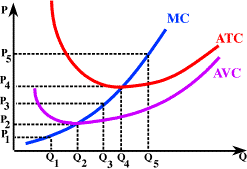
This question concerns a perfectly competitive firm. The information given, that "Mike's needs only workers and the factory to produce baseball caps", is meant only to make sure you don't make the question more complicated than intended.
The question asks how many caps the firm will produce if the market price is P1? From the graph we see that, at price P1 P = MC when the firm is producing Q1 units of output; so this seems, at first, like the correct answer. However, we know that even in the short run a firm will produce no output when P < AVC as is the case here. Thus, the firm will produce no output whatsoever.
